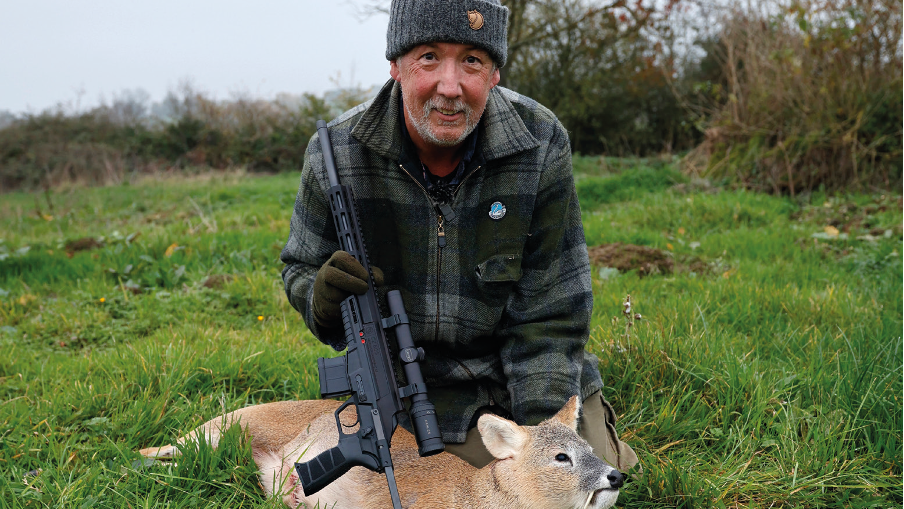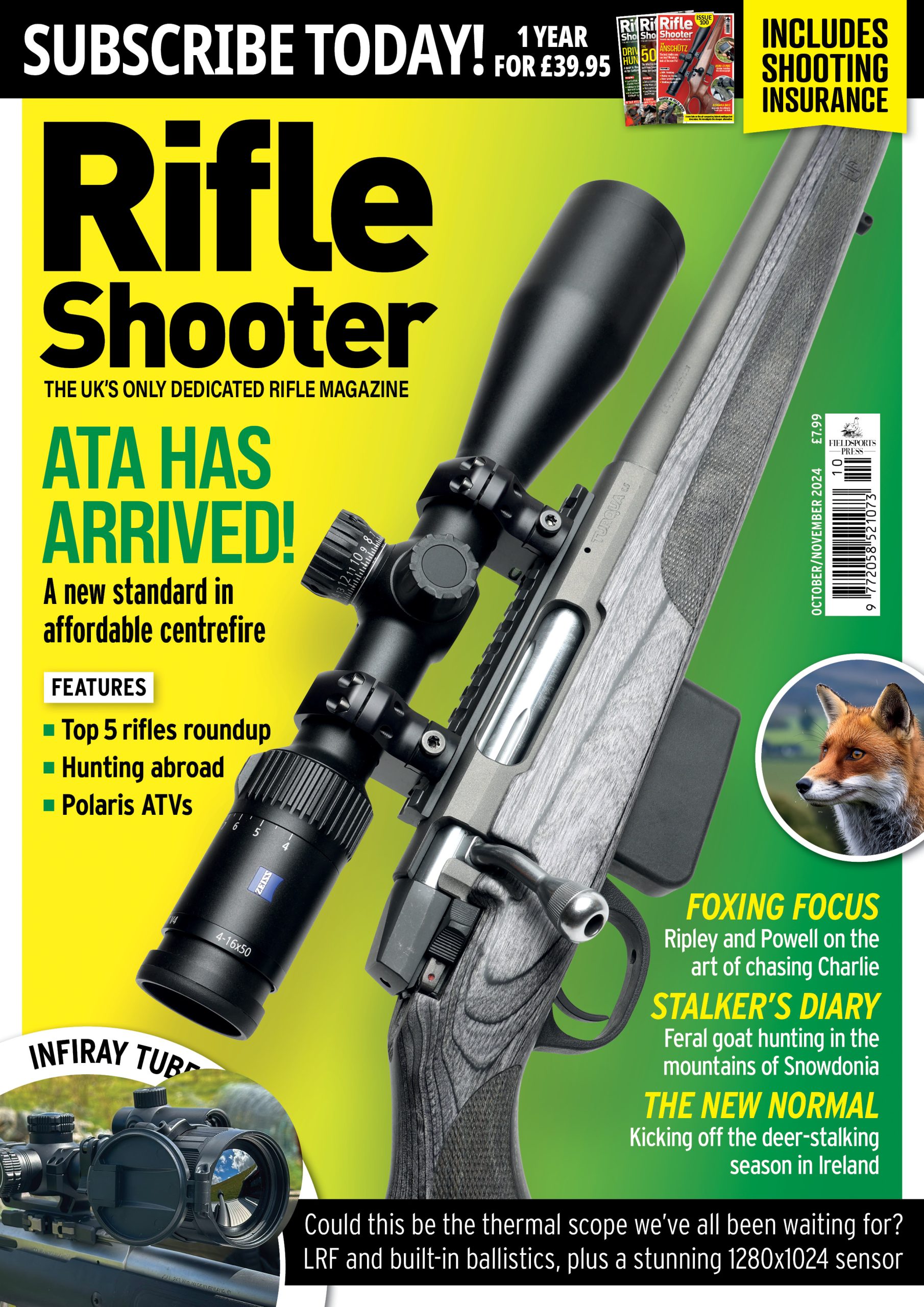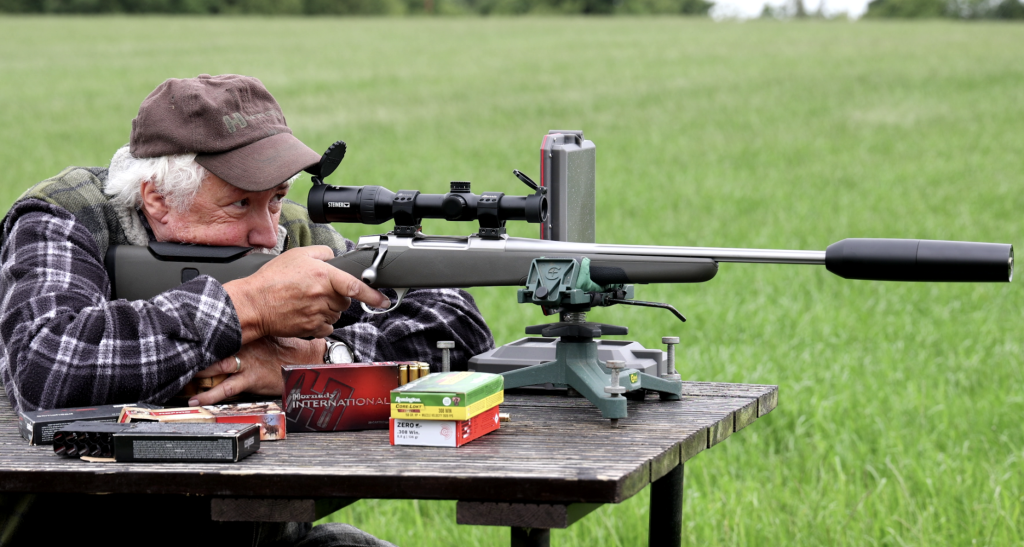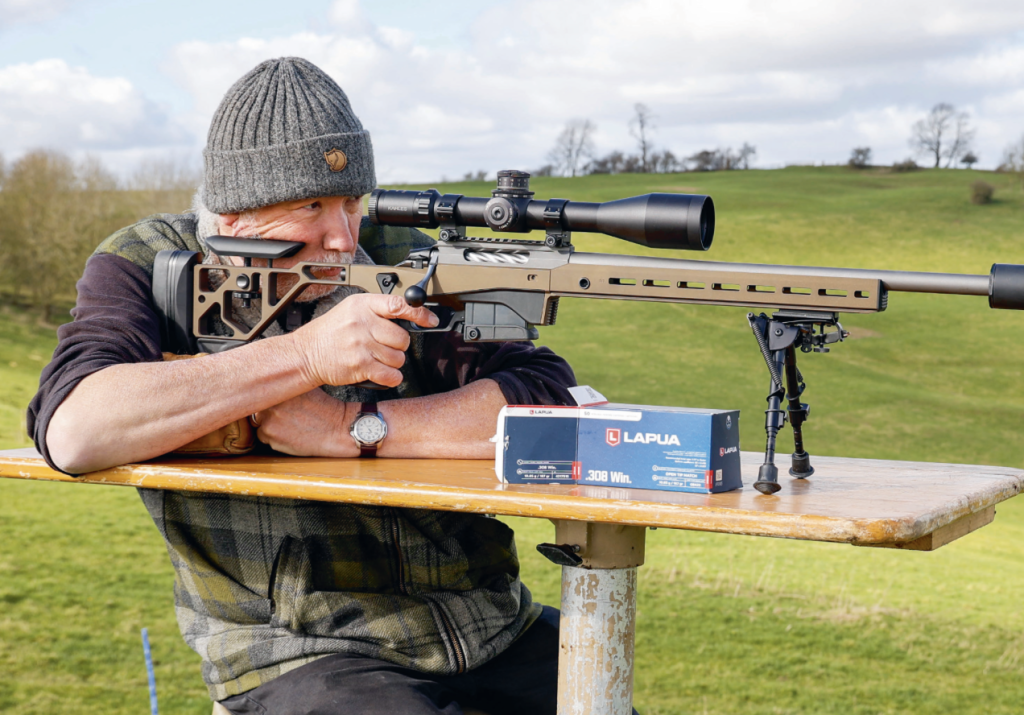CZ Trail in .300 Blackout
Bruce Potts tries out the CZ Trail, a compact and versatile rifle that blends tactical design with lightweight portability, making it ideal for stalking in tough terrain

I love a short, compact stalking rifle. In fact most of my rifles have short barrels commensurate with the ballistic efficiency of the cartridge they are firing. It makes stalking over or through tough terrain so much easier, and as the years roll on I also appreciate the lighter weight.
So I was really pleased when Gary from the Sportsman Gun Centre said, “Fancy testing a CZ Trail? It’s in .300 Blackout.” I admit the .300 Blackout caught my ears first; I love that calibre. I then quickly looked up the Trail and was pleasantly surprised to see an ultra-lightweight, compact rifle. “Yes,” was the resolute answer.
The Trail is aptly named, as it is specifically designed for use out in the woods and on trails, in a backpack or slung over the shoulder for ease of transport. It has been based on CZ’s new 600 series action, but instead of a more traditional wood or synthetic sporter-style stock arrangement, the Trail has the ever-popular tactical styling. In fact it has several key notes from the AR-15 platform with regard to safety, magazines, chassis system and exchangeable pistol grip elements.
Its best feature has to be the extendable stock section that collapses the Trail from 35.25in to a scant 27.25in. Coupled with its 2.8kg weight, this makes for a really lovely rifle to handle. It is designed exclusively for small assault rifle cartridges and is currently available in .223, 7.62x39mm or .300 Blackout (on test). It retails for £1,440.
Specification
The Trail uses a chassis system for attachment of its primary parts. The action is machined from steel and has a very slab-sided profile. This highly durable action comes with a guaranteed service life of 20,000 shots. It also has a durable finish, thanks to CZ’s new BobOx chemical heat treatment, which gives it a hard, corrosion-resistant surface.
Up top is a full-length Picatinny rail that extends to the handrail section and thus offers the best choice of sight mounting one could ask for, accommodating long, short, NV, thermal and forward-mounted sights. It sits within a lower chassis section made from high-impact polymer, further adding to the Trail’s lightweight and modular credentials.
The ejection port is 2.25in long and fairly narrow, but ejection was flawless as long as the bolt travel was fully extended, as the force of the bolt determined the speed of ejection, which placed the spent cases forward and to the right of the shooter.
The bolt design is equally interesting. The rounded steel body is nicely polished and blued, making it slick in its raceways. Its head has the locking lugs orientated in an upsidedown triple ‘A’ shape, giving a three locking-lug arrangement, with the lower lug cut away for half its depth to guide the cartridge into the chamber. A small extractor claw sits in the right-hand lug, and looking at how the lugs engage, there is good uniform contact. It is interesting to note that on this model the bolt locks directly into the back of the barrel itself, thus achieving superior alignment and strength. This three-lug system also gives a lower bolt lift of 60°, facilitating speedy bolt manipulation throughout its short travel.
The bolt handle abuts the bolt at right angles and has an S-shaped bend (for clearance of stock rails and scope), culminating in a tactical metal knob with deep twin grooves for extra grip. To the rear of the bolt is a tapered plastic bolt shroud to shield the eyes in the event of a pierced primer. The bolt release lever is just in front of the bolt stem. It is oblong in shape and needs to be depressed to release the bolt – a bit fiddly, but manageable.
For the safety system there is a very good lever on both sides, making it easily accessible in the field and from most shooting angles. With this lever lowered the Trail is ready to fire, and when in the horizontal position the rifle is safe. Note that the Trail must be cocked for the safety lever to be operated, which makes it very quiet to use – another bonus.
The trigger is equally impressive. It is curved with a slim steel blade, with the adjustment screw for weight just in front and easily accessible through the polymer trigger guard. The adjustment range allows a change between four weights, from 1.3lb to 3lb, without having to remove the receiver from the stock. This double-stage trigger has a very smooth first take-up of about 10oz, followed by a pull of 2lb 6oz on test, with a small amount of overtravel and minimal creep. It is a nice trigger to use, even with cold hands.
The ambidextrous magazine release system shows that CZ has thought about making things as easy as possible for the shooter. Twin knurled buttons are swiftly and effortlessly deployed, and the magazine pops out of the polymer lower chassis housing. The magazine itself is a STANAG-compatible design, so any AR-15 type mags will work, which really elevates the Trail’s usability. The 10-shot magazine is entirely polymer except for the spring, so it won’t rust. It has a white follower that loads in a double-stack arrangement. It was very easy to load the .300 Blackout rounds – all but the Remington Sub-X cartridges fed fine.
CZ still uses the tried-and-tested cold hammer forged method of barrel making, one of the reasons they are so well respected in the firearms world. The company’s barrels are not only accurate straight from the box but also have great longevity. This Trail has a svelte 16in barrel – perfect for the .300 Blackout round – with a diameter of 0.782in at the muzzle and a fairly straight taper. It culminates in a well-recessed and faced muzzle crown with a 15mm/1 thread pitch, which is a tad unusual. I would have thought it would use the more standard 5/8 UNEF that we see everywhere now.
The finish is a tough nitrided surface coating and secures to the CZ600 action via two Allen screws. However, these are glued in place, and although barrel exchanges can be made between calibres, CZ insists on this being a dealer-only operation. Being .300 Blackout, the rifling twist rate is 1 in 7in, which is perfect for subsonic rounds. It’s my preferred twist rate, although I know some shooters who prefer a slower 1 in 9in for supersonic rounds.
Encapsulating the barrel is a typical AR-15 type handguard, with the usual myriad of M-Lok positional attachment points. It is 10in long, with an octagonal profile 1 3/8in deep, made of aluminium with a matt anodised finish. On top is a full-length Picatinny rail to match that on the action, giving an overall scope mounting surface 16in long.
Finally, the most fascinating part of the Trail rifle is the collapsible stock section that shrinks the Trail from 35.25in to 27.25in. It uses steel guide bars on each side of the lower polymer chassis housing and a polymer end piece that guides the stock back and forth. It’s simple to operate, with one push button at the top/rear of the action that lets the stock glide out to three preset positions – 32in, 33.5in and 32in. The polymer end piece houses the drop-down butt section, complete with a Picatinny rail for a monopod and a ½in thick recoil pad that has eight seriously grippy wedges in soft rubber.
To the Range
I fitted a short Kahles Helia 1.1-4x24mm scope that I love and found to be a perfect match for the Trail’s size and ergonomics. I also fitted, via the 15mm/1 muzzle thread, the superb Wildcat Evolution over-barrel sound moderator, which was not only lightweight but also looked perfect on the Trail. The noise reduction was impressive with both supersonic and subsonic loads.
The Kahles scope, with its maximum 4x power, was a tad on the weak side for 100yd targets, but I often use low-power scopes and find that I can shoot just as well because I have a more relaxed eye box, and the eye naturally centres the reticle without any of the visual wobble that a higher-power scope promotes.
That was exactly what happened with the factory Hornady 110gr V-Max Whisper loads, which shoot 0.25in in my S&L Legacy .300 Blackout. Over a three-shot average off the bench they gave a velocity of 2,492fps for 1,518ft·lb and a 0.36in group at 100yd.
Next up were the Barnes 110gr TAC loads, with their superb flat-base, lead-free bullet and enlarged expanding tip that really opens up well on game to transfer as much energy as possible for a humane kill. Accuracy again was very good at 0.60in, with a velocity of 2,351fps and 1,350ft·lb energy. I use them a lot for small species deer as they are not only accurate, as seen here, but also quiet in the Wildcat Evolution moderator. They drop CWD or muntjac on the spot and keep the lead-free advocates happy.
The Remington OTFB bullets are a bit larger in weight at 120gr but refused to feed through the magazine, which was odd as they were the same length as some of the other bullets tested. I loaded them singly just to gather some data and achieved a nice 0.72in grouping at 2,211fps and 1,303ft·lb.
The next load also failed to feed, but this was due to the nature of the projectile tip. The Hornady Sub-X bullets at 190gr have a very flat meplat, and those stubby front-ended projectiles did not ride up the ramp to the chamber. Again, I single-fed them and was glad I did as they were superbly accurate with a 0.31in group. Velocities were low, as expected for a subsonic round, at 1,064fps and 482ft·lb. Through the Evolution mod they were whisper quiet. They are obviously not deer legal but are great fun to shoot nonetheless.
Another subsonic load was Hornady Black with its heavier 208gr A-Max bullet that was lovely and quiet with zero recoil, giving 1,083fps and 542ft·lb. I pulled the last shot and the group was 1.8in, but in reality it would be a solid 1.0–1.5in grouping cartridge.
I tried quite a few reloads with mixed results, as it is always difficult to emulate some of the factory loads, especially from Hornady. The 110gr Barnes loads produced 0.87in accuracy for three rounds at 100yd, with a load of 20.0gr of Hodgdon H110 powder, for a velocity of 2,361fps and energy of 1,362ft·lb.
The similarly weighted 110gr V-Max loads did not group as spectacularly as the Whisper factory loads, but at 100yd I still had a consistent 0.75in grouping. Velocities were brisk at 2,472fps, producing 1,493ft·lb energy with a load of 18.0gr of Vit N110.
I wanted to make amends for the Hornady Black subsonic factory load where I wobbled a bit, so I loaded up a reload of 9.5gr of Vit N110 and it shot a much better 0.87in group at 1,070fps and 529ft·lb energy.
In the Field
When the Trail arrived I was keen to take it deer stalking because the CWD season had just started. I popped down to the farm and sighted in straight away. The only problem was that I had no moderator to fit the metric 15mm thread. I therefore sighted in at 100yd with the Barnes 110gr TAC factory loads and the Kahles.
The muzzle blast even from a small Blackout round was quite aggressive, but accuracy and recoil were great, so I headed for the fields. Due to the rifle’s small stature and light weight I did without a sling, which can be fitted via M-Lok and Picatinny attachments, as it was so easy to carry cradled in my arms with the stock collapsed. It actually made crossing slippery pond banks and ditches a doddle, and I can see a gamekeeper or forestry stalker using one in .223 or .300 Blackout for small species deer and foxes as it would take up no room in the back of a 4×4.
I had noticed that many CWD used a small flight pond as a waypoint between two large field intersections and hedgerows, so chose to tuck down against a tree to avoid my silhouette spooking any deer. With the Trail nestled on my knees and the stock fully extended I could really appreciate the nimble nature of this unusual rifle. The low-power Kahles scope was a real asset too, as ranges for this stalk would only be 50yd maximum.
Just as the light was fading and the shadows on the grass fields lengthened to Lowry-like proportions, with that lovely late November glow, two CWD does suddenly appeared from nowhere. As they fed slowly towards me through the cold but gentle wind, a couple of unseen mallard on the pond flighted, which stopped the does in their tracks at about 100yd. I had the Trail up, but they seemed calm enough, so I tracked them to a safe background and mound.
I was about to take the leading doe when a buck came running from the next field – probably having been disturbed by a dog walker – and I saw him enter the hedgerow 75yd to my left. I waited and waited – a buck would be a nice start to the season. Sure enough, he slowly broke cover from the hawthorns and started to make his way towards the does. I squared up the Trail, rested on my knees, and despite the small cheekpiece had a pretty stable position. I eased the safety off when the buck stopped at 55yd. The Trail barked, and through the Kahles I saw him drop instantly. The recoil was so low that I actually saw the bullet strike, right in the heart region.
The two does, instead of running off, cautiously walked over to the downed buck, and I had to wait 20 minutes for them to finally wander off, as one CWD was enough. As I approached the buck I saw that he was a nice beast with decent tusks, although the left one was half broken off. Still, he was still a great way to prove the capabilities of the CZ Trail as a compact stalking rifle in the field.
Conclusions
I liked the Trail very much. Despite the obvious foibles of a rattly stock and small cheekpiece, which I am sure can be rectified, it proved to be not only an accurate compact rifle to shoot but also really effortless to carry in the field. The price is good too, and if .300 Blackout is not to your liking then the .223 version would make a great all-round keeper’s or forestry gun.
Related Articles
Get the latest news delivered direct to your door
Subscribe to Rifle Shooter
Elevate your shooting experience with a subscription to Rifle Shooter magazine, the UK’s premier publication for dedicated rifle enthusiasts.
Whether you’re a seasoned shot or new to the sport, Rifle Shooter delivers expert insights, in-depth gear reviews and invaluable techniques to enhance your skills. Each bi-monthly issue brings you the latest in deer stalking, foxing, long-range shooting, and international hunting adventures, all crafted by leading experts from Britain and around the world.
By subscribing, you’ll not only save on the retail price but also gain exclusive access to £2 million Public Liability Insurance, covering recreational and professional use of shotguns, rifles, and airguns.
Don’t miss out on the opportunity to join a community of passionate shooters and stay at the forefront of rifle technology and technique.




